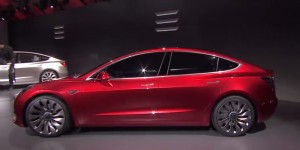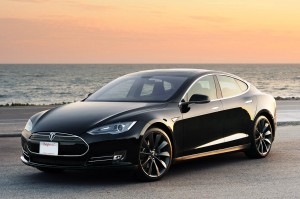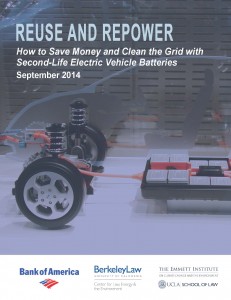 Tesla has done amazing work pioneering electric vehicles and forcing positive change toward EVs within the broader industry. But the company will risk its progress and investor enthusiasm if it’s first “mass market” vehicle — the new Model 3 — is unreliable.
Tesla has done amazing work pioneering electric vehicles and forcing positive change toward EVs within the broader industry. But the company will risk its progress and investor enthusiasm if it’s first “mass market” vehicle — the new Model 3 — is unreliable.
And so far, the news is not good. Green Car Reports just reviewed the Model 3 and had this to report:
During the test itself, two things became clear: The Model 3 works largely as intended, and the build quality was the worst we have seen on any new car from any maker over the last 10 years.
The company was reviewing a car that had just been delivered in January, as production was ramped up at Tesla’s Fremont factory. The owner was not pleased with the vehicle:
We took delivery of our Model 3 today. It looked like everything was working OK until we got within about 10 miles of the house. That was when the touchscreen started to malfunction.
It is getting random touches along the right side of the screen. The worst part is that the stereo will go to full volume without notice. It also makes the map and navigation mostly useless. I called Tesla and they had me try rebooting the screen several times.
Unfortunately it didn’t resolve the issue. They said they would call me back [within 24 hours] to attempt a software update or to schedule a service call. Nothing like paying $50,000 to be a beta tester. Again.
I hope this is just a stroke of really bad luck for Tesla. But the higher-end Models S and X have also had these quality problems, although with an upper-income clientele that is more forgiving and able to weather having to bring their car to the shop. But the Model 3 is supposed to be an every day car for middle class buyers. So a reputation for unreliability could undermine that claim.
Tesla is relying on its brand as an innovative 21st century high-tech company with a luxury good. And certainly any new model car can have its growing pains, as we’ve seen for example with the otherwise high-quality Chevy Bolt EV. But if more stories about the cars falling apart surface, Tesla’s very survival could eventually be at stake.
The federal tax bill back in December spared the generous $7500 EV tax credit that a purchaser of an electric vehicle now receives. But not all the automakers are jumping for joy about it, particularly GM and Tesla. As the New York Times explained:
That’s because as now structured, the tax credit puts Tesla and G.M. at a competitive disadvantage, especially compared with foreign rivals who are just starting to ramp up electric vehicle sales in the United States. The tax credit begins to phase out after a company sells 200,000 electric vehicles — a threshold both Tesla and G.M. are expected to reach this year.
Meanwhile, buyers of electric BMWs, Volkswagens and Volvos will continue to get the full $7,500 credit. All of those manufacturers have announced aggressive sales plans for electric vehicles in the United States but so far have sold relatively few of them.
It now seems clear that limiting the taxes to 200,000 vehicles per automaker, as opposed to an industry-wide credit or one that expires for all companies by a date certain, will penalize EV pioneers like Nissan, GM and Tesla going forward. Their vehicles will soon be more expensive than competitors’ who waited to introduce their EVs until now and will therefore have customers who can take advantage of the tax credit for their company.
 It’s already affecting customers who want to buy Tesla’s “mass market” Model 3. Many of them were hoping to get the cheaper version of the vehicle before the tax credit expires for the company, but Tesla is first introducing the more expensive version of the car with longer range. Customers who want the cheaper model will probably be out of luck by then, tax credit-wise.
It’s already affecting customers who want to buy Tesla’s “mass market” Model 3. Many of them were hoping to get the cheaper version of the vehicle before the tax credit expires for the company, but Tesla is first introducing the more expensive version of the car with longer range. Customers who want the cheaper model will probably be out of luck by then, tax credit-wise.
With Republicans in charge of congress, it’s unlikely they’ll change the current EV tax credit structure. But ideally it would be reformed to affect all companies equally, while phasing out over time to reflect the decreasing costs of producing the vehicles.
Tesla’s tiled solar panel roof made a big splash when Elon Musk unveiled it last year (photo to the right). But the roof comes at a pretty steep price, as Bloomberg reports:
A Tesla solar roof will also lose some of the energy-generating density of a traditional panel, because the cells must be spaced farther apart to account for the edges of the tiles, BNEF’s Bromley said. Therefore, the percentage of the roof that will be covered by active solar cells will be higher, as will the total cost of the roof. All told, a traditional solar setup might be 30 percent cheaper than a Tesla roof, he said, but Tesla’s will look better and come with a lifetime warranty. “A 30 percent premium could well be acceptable.”
“It is the most affordable roof you can buy, all things considered,” said Peter Rive, co-founder of Tesla’s recently acquired SolarCity division.
Perhaps the extra cost is worth it in terms of getting a new roof and possibly not having the visual impacts of a traditional solar array (I personally don’t mind the look of traditional solar panels, but some people do, which could decrease home values I suppose). But only so many homes need a new roof at a given time, so right away the market seems limited.
There also may be technical issues with this new type of technology. I talked to a solar engineer recently who thought the tiles would have problems without having the cooling air space underneath, like with traditional mounted panels. The extra heat would supposedly hinder the lifespan and energy production value. I don’t know how to evaluate that claim or whether or not Tesla has addressed it, but it points to concerns people may have with adopting a new form of the technology.
I like the idea of Tesla combining with SolarCity to package clean energy and energy storage together with the vehicles, but the solar roof concept may have a rocky start.
Tesla driver Alex Venz got a 24-hour test drive of the new Chevy Bolt EV, as I did, and put together an extended video review. You could read an article write-up or see the video above. He gets into much more detail on all the various features and offers some helpful comparisons to the Tesla Model S (including his own 0-60 mph acceleration tests).
Meanwhile, initial sales figures for the Bolt are looking good, in just its first full month on sale in January. Green Car Reports describes the numbers:
When GM released its sales results this morning, the number turned out to be 1,162 deliveries. That brings total Bolt EV sales in roughly six weeks to 1,741—far ahead of both the Chevrolet Volt and Nissan Leaf after their first two months exactly six years ago.
The Volt plug-in hybrid, meanwhile, logged its own January sales of 1,611, against 996 in January 2016.
Including a few remaining Spark EVs, that means GM sold about 2,800 cars with plugs last month.
This is definitely a car to watch going forward.
It’s official: Tesla shareholders approved a merger with SolarCity. Despite financial analysts’ concerns, the basic concept makes sense: electric vehicle drivers will want solar panels to make fueling the vehicle at home cheaper. Solar customers will be interested in electric vehicles because they already have cheap fuel at home. So there are big marketing/customer acquisition benefits.
 But more importantly, as rooftop solar sales decline and state regulators pull back on incentives, batteries will be crucial to keep solar competitive. Why? Right now most rooftop solar customers use the grid as their battery. I have panels on my home, for example, and when I have surplus electricity in the summer, I export to the grid and get a retail credit for that surplus. I then apply that retail credit to my grid usage in the dark winter months, and “true up” after a full year accounting.
But more importantly, as rooftop solar sales decline and state regulators pull back on incentives, batteries will be crucial to keep solar competitive. Why? Right now most rooftop solar customers use the grid as their battery. I have panels on my home, for example, and when I have surplus electricity in the summer, I export to the grid and get a retail credit for that surplus. I then apply that retail credit to my grid usage in the dark winter months, and “true up” after a full year accounting.
But regulators are doing away with that bargain already in places like Hawaii and Nevada. Soon new solar customers are going to need an actual battery to store their surplus solar. It would be the same model that I have, but you no longer need the grid to store your electricity, and you don’t need regulators requiring utilities to do so. Instead, with a big enough battery, you capture and use all your solar energy on site.
The one question I have is whether the economics are still good enough to encourage people to purchase both a battery and solar array. I doubt a typical Tesla home battery will be big enough to capture all the surplus energy in the summer months, meaning some power will be lost that the grid would otherwise have used. But as battery and solar prices decrease and electricity rates increase, the deal could be good enough.
Either way, the merger represents a sea change in our electricity system, packaging transportation and home energy use in a way we’ve never seen. If all goes well for the company, Tesla could one day become a monopoly like we’ve never seen, with a gas station, utility, and car company all rolled into one.
On Friday, Elon Musk unveiled a way to make solar panels as sleek and cool as Tesla has made electric cars. You can watch the video above, but it’s hard not to feel like this is the future of solar panels. The panels are broken down into tiles that (according to the video and photos) look pretty much exactly like real roofing material. According to Musk, they are also supposedly sturdier than everyday roofing material. In short, there’s no negative aesthetic impact from the panels, while you get a better roof in the process.
 You can see photos here from Tech Crunch. And here’s the slate tile model, in the photo on the right. As you can see, it’s hard to tell that there’s any solar PV modules in there. It looks “real.”
You can see photos here from Tech Crunch. And here’s the slate tile model, in the photo on the right. As you can see, it’s hard to tell that there’s any solar PV modules in there. It looks “real.”
Musk made a point to say that the cost of the solar roof is less than the cost of a new roof plus electricity. That could be the case, but right now we don’t have any cost figures on the solar roof. We also know that the solar roof panels are not as efficient as regular solar panels (as the Tech Crunch article points out), and presumably any homeowner would be paying for panels in inefficient (i.e. shaded) parts of the roof. Plus, they wouldn’t be sized to the demand on-site, so customers may be paying for too much solar production compared to the retail credit they can get to offset their usage.
And of course, how many people are replacing their roofs in any given year? If the average roof lasts 25 years, that means just 4% of the market, and probably less given that many people are renting or living in multi-unit dwellings without access to their roof.
But Musk knows that the incentives around rooftop solar are diminishing across the country. As his PowerWall battery gets cheaper, solar customers are going to want to bundle solar with storage, effectively making any utility credit system pointless. After all, why be dependent on regulators giving you retail credit for any surplus solar you generate, when you can just use all your solar energy on-site as you store it for nighttime and cloudy days in your battery?
So lots of unanswered questions, but one thing is clear: solar panels just became sleek and cool — something you couldn’t necessarily say before Friday.
A common concern about the “greenness” of electric vehicles is that the batteries have a negative environmental footprint, from manufacturing to disposal. True, batteries have an environmental cost, but it is minimal over the lifecycle of the vehicles compared to the alternative of a petroleum-fueled vehicle (of course, the true alternative of walking, biking or transit is the ideal, if not always practical for most people).
But there is also a huge environmental upside to the battery: the prospect of hundreds of thousands of used, cheap batteries available to bottle surplus renewable energy for later use. As David Roberts on Vox.com described:
In four or five years, the batteries in the roughly one and a quarter million EVs currently on the road are going to start to wane. EV owners will either replace them, or replace the cars entirely.
That means we’ll have a lot of used batteries on our hands — batteries with plenty of life left in them, but which are no longer suitable for EVs. What to do?
 It’s worth reading the article in full for an overview. Or you can see our UC Berkeley/UCLA Law report on the subject back in 2014, Reuse and Repower: How to Save Money and Clean the Grid with Second-Life Electric Vehicle Batteries.
It’s worth reading the article in full for an overview. Or you can see our UC Berkeley/UCLA Law report on the subject back in 2014, Reuse and Repower: How to Save Money and Clean the Grid with Second-Life Electric Vehicle Batteries.
A lot has happened since that report came out, particularly with pilot projects. For example, as the MIT Technology Review reported, BMW combined batteries from 100 cars for a grid-scale energy storage facility in Hamburg, Germany, which is capable of storing 2.8 megawatt-hours of energy and delivering up to two megawatts of power. It’s designed to meet periods of peak demand to avoid having to ramp up fossil-fueled power plants. And a French web hosting company in Normany is deploying used Nissan EV batteries to capture surplus renewables to lower energy costs. These are just a few of the growing number of pilot projects happening around the world.
And studies on the subject are increasingly bullish. Fortune covered a new report this past summer from Bloomberg New Energy Finance, which predicts that roughly a third of electric car batteries are expected be reused by 2025, totaling 29 gigawatt hours of used batteries. 10 gigawatt hours of those could be repackaged for grid needs.
But the challenges are myriad. Greentech Media has a great article describing the barriers and options going forward, many of which we discussed in our 2014 report:
“Batteries are a lot like people: They each have their own individual state of health depending upon what they’ve been exposed to and how they’ve been treated over the course of their life,” said Ken Boyce, who’s developing a safety standard for second life batteries at Underwriters Laboratories, a major safety certification firm.
But despite the potential and progress being made, one major automaker is notably absent in these efforts: Tesla. As the Bloomberg New Energy Finance report author Claire Curry observed in Greenwire [paywalled]:
Tesla, however, is not one of the players, partly because it is more interested in recycling batteries at its Gigafactory in Nevada, Curry said.
“Tesla has so much stationary storage capacity it needs to sell,” she said.
I asked Elon Musk about his interest in used EV batteries in early 2014 at a public event, and he said he was absolutely in favor. His staff later approached me to walk back his comments a bit. It seems that they want to make money selling new batteries and don’t want the competition from cheap used ones.
But Tesla may be swimming against the tide, as a surge in used EV batteries could change the energy storage market and clean the grid for the better — starting in just a few short years.
I’ve heard people refer to self-driving cars as nothing more than a “George Jetsons” future that won’t really happen, or at least is decades away. But Tesla just brought that reality into the present.
Yesterday the automaker announced that all their new cars going forward will be equipped with the hardware for full automation. That includes:
Eight surround cameras provide 360 degrees of visibility around the car at up to 250 meters of range. Twelve updated ultrasonic sensors complement this vision, allowing for detection of both hard and soft objects at nearly twice the distance of the prior system. A forward-facing radar with enhanced processing provides additional data about the world on a redundant wavelength that is able to see through heavy rain, fog, dust and even the car ahead.
The software won’t be activated right away, and customers will have to pay to access both the hardware and the software. Still, the era of autonomy is now within reach, and it will require policy makers to get ahead of the curve to ensure it doesn’t increase traffic.
The no-regrets solutions? Encourage car-sharing instead of vehicle ownership, and start charging drivers for the miles they drive rather than taxing them based on fuel.
You can see Tesla’s promotional video here, showing the self-drive in action:
In Fortune, former Tesla VP Cristiano Carlutti dishes on the company and the upcoming Model 3 (Tesla’s first mass-market EV, due in 2017):
As far as the downsides of the Tesla Model 3, let’s try to look at things from a different perspective: the biggest downside of Model 3 in my opinion is that it doesn’t exist yet. Lots of things can change until the launch date and I would assume that, when it was presented earlier this year, Model 3 was probably nowhere near a decent stage of development.
In order to understand this perspective, you have to take a different look at the way the company operates: in my opinion, it’s fundamentally a very focused marketing machine that until now has been focused on selling shares, with car sales instrumental to that. Before some fans attack me because of this comment, let me tell you that… it was the right thing to do!
In other words, Elon perfectly knew since the beginning that he would need a massive amount of money to become a car OEM and that, in order to raise that money, he had to create and sustain excitement in investors even more than in clients. Another way to look at it is that at this prices, the purchase of Tesla stock is more irrational than the purchase of a Model S: the latter is a very good car, competitive in its market, while the stock is more of a bet (or a gamble) on future dividends that nobody knows if they will ever appear. Car sales and car fans are just instrumental to raise the money Tesla needs to reach the point where it will be self-sustainable: the gamble is that financial markets keep drinking the company’s kool-aid at least until the company becomes self-sustainable. If they stop drinking it too soon, it will be game over and an historical failure, if believers sustain the company long enough, it will be a masterpiece of entrepreneurship and a tremendous success.
A lot is at stake with the future of Tesla. The company is, in my view, the most important private sector clean technology purveyor out there. Elon Musk has almost single-handedly pushed EVs to the forefront of the public imagination, spurring other automakers to follow suit. He also is betting big on energy storage and its marriage with solar PV, which will be essential to decarbonizing the grid. Combined with electric transportation, Tesla’s technology deployment promises to help the world decarbonize at a much greater rate than we otherwise would.
I don’t want to overstate it, but Tesla is making a strong claim to being in position to quite literally save the world (at least from out-of-control climate change).
So we need the company to succeed and raise the capital it needs for the deployment it envisions. If Carlutti is to be believed, let’s hope Musk can keep stoking the imagination of investors — and more importantly, that he and his team can deliver on their big promise with the Model 3. They’ll need a car that meets expectations at the right price and delivery time, without some of the quality issues plaguing the Model S.
It’s possible to do, but not certain. Reason for us all to be nervously optimistic.
It’s looking pretty fair to expect some big things from the Chevy Bolt EV, the first mass-market electric vehicle due out later this year.
Road Show’s editor-in-chief drove a pre-production Bolt from Monterey to Santa Barbara and reviewed it by video along the way. For those keeping score, that’s 240 miles on a single charge. It’s worth watching the video in full:
It’s looking more and more like Tesla just got scooped big time by Chevy on the mass-market EV.
But it’s also worth noting that Chevy has some serious advantages over Tesla. In addition to the production scale that Chevy can achieve in-house, it has the ironic advantage of selling a lot of dirty cars. The New York Times has a fascinating account of how Chevy beat out Tesla, and they cite this advantage:
Finally, G.M. enjoys the regulatory advantage of producing a fleet. Because the high-mileage, zero-emission Bolt helps the company stay under the federal government’s fuel-economy standards, it perversely allows G.M. to keep selling more profitable, gas-guzzling cars, like the Tahoe S.U.V. As a result, G.M. could lose money on each Bolt and still find the overall project valuable to its bottom line.
Tesla may benefit from a lot of zero emission vehicle credits from other automakers, but this regulatory quirk of fleet average emissions certainly benefits big automakers like Chevy over cleaner companies like Tesla.
But in the end, the more mass-market EVs on the road, the better — for both the consumer and the environment.


